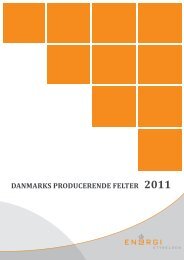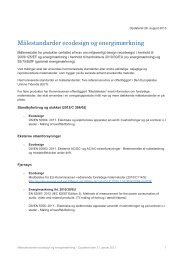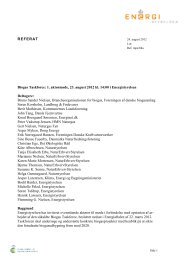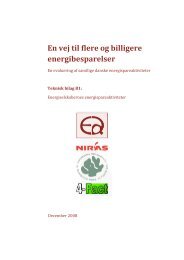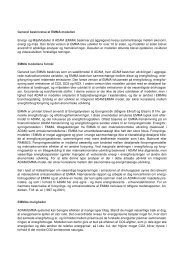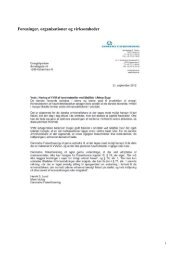Energy Strategy 2050 – from coal, oil and gas
Energy Strategy 2050 – from coal, oil and gas
Energy Strategy 2050 – from coal, oil and gas
Create successful ePaper yourself
Turn your PDF publications into a flip-book with our unique Google optimized e-Paper software.
On the way towards fossil fuel independence by <strong>2050</strong> <strong>–</strong> effects <strong>and</strong> benefits of the government’s initiatives<br />
%<br />
33<br />
30<br />
25<br />
20<br />
15<br />
Figure 4.6. Share of renewable energy in final energy consumption<br />
2006-2020. Source: Danish <strong>Energy</strong> Agency<br />
The significant expansion of renewable energy will<br />
ensure, that Denmark keeps its place as a global leader<br />
in raising its RE share. Up to 2020, consumption of biomass,<br />
wind, bio<strong>gas</strong> <strong>and</strong> biofuels will increase significantly<br />
as a consequence of existing <strong>and</strong> new initiatives. With a<br />
significant increase in solid biomass, bio<strong>gas</strong> as well as<br />
biofuels, bioenergy will continue to make up the majority<br />
of total renewable energy consumption in 2020, see<br />
figure 4.7.<br />
250<br />
0<br />
2000 2005 2010 2015 2020<br />
Other Wind Bio<strong>gas</strong> Biofuel Biomass<br />
Figure 4.7 Renewable energy in primary energy consumption<br />
2000-2020. Source: Danish <strong>Energy</strong> Agency<br />
50<br />
33% by 2020<br />
0<br />
2006 2008 2010 2012 2014 2016 2018 2020<br />
Without initiatives With new initiatives EU target<br />
200<br />
150<br />
100<br />
PJ<br />
50<br />
<strong>Energy</strong> <strong>Strategy</strong> <strong>2050</strong> <strong>–</strong> <strong>from</strong> <strong>coal</strong>, <strong>oil</strong> <strong>and</strong> <strong>gas</strong> to green energy.<br />
It has been estimated that the RE share will continue to<br />
increase after 2020, depending on price developments,<br />
new initiatives etc. With the government initiatives for<br />
expansion of wind <strong>and</strong> biomass, Denmark is well on its<br />
way to having an energy <strong>and</strong> transport system based<br />
on renewable energy by <strong>2050</strong>. This is illustrated in figure<br />
4.8.<br />
100<br />
90<br />
80<br />
70<br />
60<br />
50<br />
40<br />
30<br />
20<br />
10<br />
0<br />
33 % by 2020<br />
2010 2015 2020 2025 2030 2035 2040 2045 <strong>2050</strong><br />
Without initiatives With new initiatives<br />
Figure 4.8. RE-share 2010 to <strong>2050</strong><br />
Source: Danish <strong>Energy</strong> Agency<br />
%<br />
A lower energy consumption<br />
With the proposed initiatives, this strategy will help<br />
reduce gross energy consumption in 2020 by significantly<br />
more than expected, as it has been estimated,<br />
that gross energy consumption will be reduced by 6%<br />
by 2020, relative to 2006. Thus, the target of reducing<br />
gross energy consumption by 4% by 2020 compared to<br />
2006 will be more than met. This means, that Denmark<br />
is well on its way to meeting the government’s goal of<br />
being one of the three most energy-efficient countries in<br />
the world by 2020.




